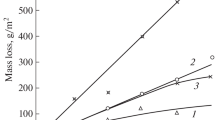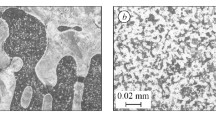Scanning electron microscopy and x-ray microanalysis were used to study defects in protective diffusion coatings on the blades of gas-turbine engines. It was established that the defects in the coatings on the flowthrough surface of the middle of the blades are caused by the entry of corundum particles into the surface of the heat-resistant alloy during the pneumoabrasive treatment administered to the blade surface. Defects are formed in the coatings on the inside surfaces of the cooled channels due to the use of an oxidizing atmosphere in the gas-circulation chromizing-aluminizing operation and leaching of carbides from the alloy when ceramic cores are removed from the blade castings. It is shown that the technology of hydrothermal autoclave leaching in a protective argon atmosphere makes it possible to remove corundum particles embedded in the flow-through surface of the middle of the blades and properly prepare the surface of the internal cooled channels for the application of quality protective diffusion coatings.







Similar content being viewed by others
References
E. N. Kablov, N. V. Petrushin, I. L. Svetlov, and I. M. Demonis, “A new generation of heat-resistant nickel foundry alloys for GTEs,” Aviation Materials and Technologies: Anniversary Scientific-Technical Collection (a supplement to the journal Aviationnye Materialy i Tekhnologii), VIAM, Moscow (2012), pp. 36–52.
E. N. Kablov and S. A. Muboyadzhyan, “Heat-resistant and heat-protective coatings for the blades of the high-pressure turbines of future GTEs,” ibid., 60–70.
R. Pishar, “The main parameters that determine the structure and composition of aluminide coatings on heat-resistant alloys based on nickel and cobalt,” Proc. Int. Conf. Heat-Resistant Alloys for Gas Turbines [Russian translation], Metallurgiya, Moscow (1981), pp. 106–124.
M. Hocking,W. Vasantasree, and P. Sidky, Metallic and Ceramic Coatings: Production, High-Temperature Properties, and Applications [Russian translation], Mir, Moscow (2000).
B. N. Arzamasov, Chemico-Thermal Treatment of Metals in Activated Gaseous Media [in Russian], Mashinostroenie, Moscow (1979).
Yu. S. Eliseev, N. V. Abraimov, and V. V. Krymov, Chemico-Thermal Treatment and Protective Coatings in Aircraft Engine Construction [in Russian], Vysshaya Shkola, Moscow (1999).
B. N. Arzamasov, A. K. Belyavskii, A. V. Logunov, et al., “Circulation method of obtaining diffusion coatings on parts of gas-turbine engines and prospects for its further development,” Vestn. Mashinostr., No. 11, 43–48 (1991).
A. M. Beltran and D. A. Shores, “High-temperature corrosion,” Heat-Resistant Alloys [Russian translation], Metallurgiya, Moscow (1976), pp. 293–320.
J. Stringer, “High-temperature corrosion of superalloys,” Mat. Sci. Tech., 3, No. 7, 482–493 (1987).
J. X. Zhang, H. Harada,Y. Koizumi, and T. Kobayashi, “Crack appearance of single-crystal nickel-base superalloys after thermomechanical fatigue failure,” Scripta Mat., 61, 1102–1108 (2009).
V. A. Poklad, O. G. Ospennikova, M. R. Orlov, and M. A. Sudinin, “Technology for removing ceramic cores from cooling gas-turbine-engine blades,” Aviats.-Kosmich. Tekh. Tekhnol., No. 9/35, 24–30 (2006).
O. G. Ospennikova, M. R. Orlov, and L. A. Gubenko, “Ensuring the quality of the surface of blades during the hydrothermal leaching of ceramic cores,” Lit. Proizvod., No. 8, 31–34 (2007).
U.S. Patent No. 4.188.237, Method for Cleaning Metal Parts with Elemental Fluorine, Appl. No. 874,915, Filed Feb. 2, 1978.
U.S. Patent No. 4.324.594, Method for Cleaning Metal Parts, Appl. No. 119,060, filed Feb. 2, 1980.
U.S. Patent No. 4.328.044, Method for Cleaning Metal Parts, Appl. No. 119,061, filed Feb. 6, 1980.
U.S. Patent No. 4.405.379, Method for Cleaning Metal Parts, Appl. No. 314,594, filed Oct. 26, 1981.
E. A. Sadreev, A. V. Logunov, V. S. Shaidurov, et al., USSR Author’s Certificate No. 1819296, IPC C23G1/28, Melt for Cleaning Ceramics from Castings, Appl. No. 4719125/26, 07.18.1989, publ. 05.30.1993.
E. S. Sadreev, “Technology for removing ceramics from the internal cavities of monocrystalline GTE blades in a melt of fluoride salts,” Aviats. Prom., No. 1, 43–45 (2003).
L. A. Gubenko and V. I. Snop, Russian Federation Patent No. 2151026, IPC B22F3/14, Isostat for the Treatment of Materials in Liquid, Appl. No. 99123273/02, 11.10.1999, publ. 06.20.2000.
V. I. Snop, Russian Federation Patent No. 2245220, IPC B22F3/14, Isostat for Treating Materials and a Method for Using It to Remove Ceramic Material from Metal Products,Appl. No. 2003134260/02, 11.26.2003, publ. 01.27.2005.
Author information
Authors and Affiliations
Corresponding author
Additional information
Translated from Metallurg, No. 2, pp. 77–84, February, 2013.
Rights and permissions
About this article
Cite this article
Orlov, M.R., Ospennikova, O.G. & Karachevtsev, F.N. Ensuring the Quality of the Surface of Turbine Blades by the Application of Protective Diffusion Coatings. Metallurgist 57, 144–153 (2013). https://doi.org/10.1007/s11015-013-9704-2
Received:
Published:
Issue Date:
DOI: https://doi.org/10.1007/s11015-013-9704-2




